Big Bird Takes Flight
Posted on: 17 October 2022 by Amanda Draper, Curator of Art and Exhibitions in 2022
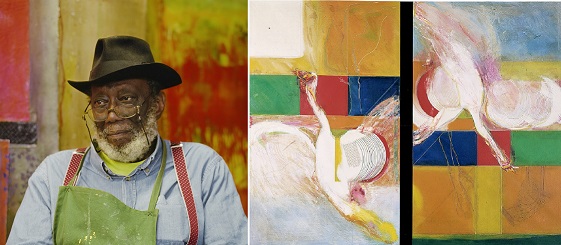
Big Bird by Sir Frank Bowling RA is one of the largest paintings in our collection and has been loaned to several prestigious London exhibitions. Here’s a behind-the-scenes look at the painting and the logistics involved in its journeys.
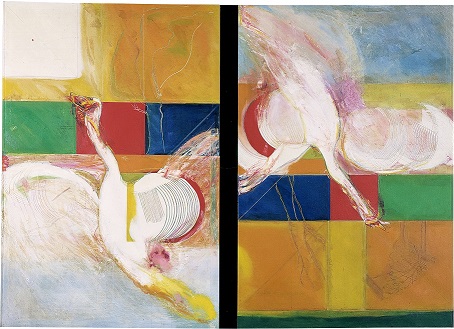
Frank Bowling: Big Bird, 1964 (oil on canvas with velvet). © Frank Bowling. All Rights Reserved, DACS 2022. Courtesy the artist and University of Liverpool.
Frank Bowling and the swan
Big Bird is a large oil painting in two sections which together measure 179cm (height) by 200cm (width) and it was gifted to the University’s art collection in 1975 by the Contemporary Art Society. It features a white swan flying upwards on the left panel and falling downward on the right.
The artist, Sir Frank Bowling OBE RA, was born in Guyana (then British Guiana) in 1934 and came to Britain in 1953 when he was nineteen. After completing his National Service with the RAF, Sir Frank studied at Chelsea School of Art and then won a scholarship to study at the Royal College of Art in London. He graduated in 1962, winning the Silver medal for painting with fellow-student David Hockney winning the Gold. Sir Frank made an immediate impact on the artworld with his striking style which combined figurative and symbolic elements with colourful abstraction. Big Bird is from the early part of his long career and was painted in 1964.
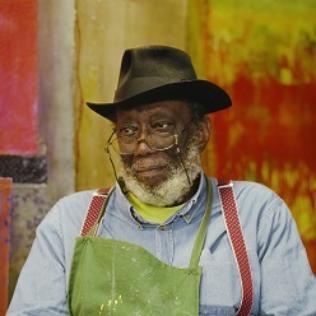
Frank Bowling, 2014 © Nicholas Sinclair. All rights reserved, DACS 2022.
Sir Frank became intrigued by swans because they symbolised different aspects of his life in the early 1960s. Although he was successful in the artworld, his home life was complicated and Sir Frank said he felt “the stresses of domestic life”. So, like a healthy swan, he appeared serene on the outside, but inside he struggled like a distressed or injured swan resulting in a series of paintings on the theme. The swan motif also evolved from Sir Frank’s empathy with outsiders in society like beggars and others with “broken lives”. He heard people saying phrases like “… if you don’t straighten up and fly right … you’re going to end up in the gutter like those people out there.” (quotes from Mel Gooding: Frank Bowling (London, Royal Academy of Arts, 2021) pp.46 – 53)
In Big Bird, the left panel shows a flying swan that has been injured and has blood around its beak, while the right panel shows it falling to the ground. Despite its sad subject, Big Bird is set against a colourful backdrop laid out in a grid formation which has echoes of the work of Piet Mondrian, a Dutch Modernist painter whose work Sir Frank studied at art school.
Later work
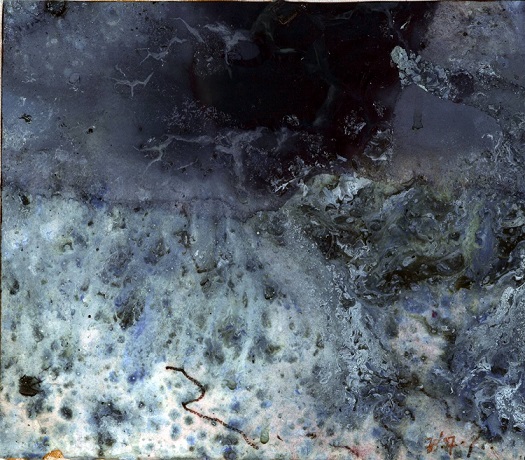
Frank Bowling: Clutch, 1987 (Acrylic gel & mixed media on paper). © Frank Bowling. All Rights Reserved, DACS 2022. Courtesy the artist and University of Liverpool.
In 1966 Sir Frank moved to New York and his work moved towards complete abstraction, concentrating on the process of making with materials and colours. From 1975, he moved between studios in London and New York, and by the mid-1980s Sir Frank had a studio in East London close to the Thames. We are lucky to also have a work from this period in our collection: Clutch (shown above). It is inspired by the reflection of light off the river and the British landscape tradition of Turner and Constable. To get an aquatic effect Sir Frank used acrylic gel paints, and he compared using them to playing with water and mud at his childhood home in Guyana. At the same time, Sir Frank was increasingly aware of environmental issues and concerns about plastics contaminating the planet. He would sometimes incorporate strips of plastic foam, small toys or glitter into his paintings to highlight issues of pollution.
Now in his late 80s, Sir Frank continues to create and push artistic boundaries, with his recent work bringing together techniques of pouring paint, stencilling, collage and stitching. He was elected to the Royal Academy in 2005, the first African diaspora artist to gain this recognition, then awarded an OBE in 2008 and a knighthood in 2020.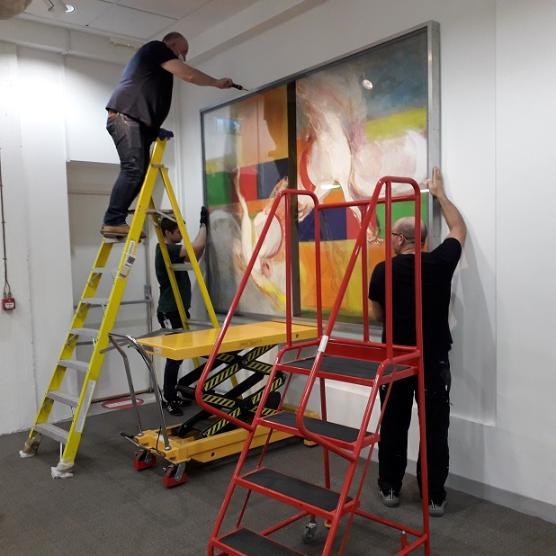
VG&M’s Ben plus Pete and Ste from MUSES take down Big Bird
Bird Bird on its travels
Sir Frank’s artistic reputation has remained high throughout his career, but he came to more popular recognition with a long-overdue retrospective held at Tate Britain between May and August 2019. The exhibition curators wanted to borrow Big Bird and, typical of major exhibitions, the request came through by letter more than a year before the show was due to open. We were very proud to be able to contribute to this important exhibition. Not long after Big Bird was returned to us after the Tate show, we had another request for the painting to be lent to an exhibition at the Barbican in London, called Postwar Modern, from March to June 2022. Again, we were pleased and honoured to be able to contribute.
Loaning artworks, especially large and important ones, takes a lot of organisation by both sides. There is a lot of documentation sent between the lending and borrowing institutions: a facilities report showing that the gallery where the artwork will be housed has the appropriate environmental conditions and security; a loan agreement from the lenders giving extensive information about the painting and detailing any special requirements it needs. Often the lender will ask to send a member of their curatorial staff to oversee transit and installation of the artwork. Just before the artwork is despatched, curatorial staff will complete a highly detailed condition report, showing where there may be weaknesses or existing defects. This is checked on arrival by the receiving staff to see if there has been any change during transit. Sometimes remedial treatment or full conservation is required before the loan goes ahead. Unless you are very excited by paperwork, this can all be a little dull. The real action happens when the artwork is actually due to be shipped out.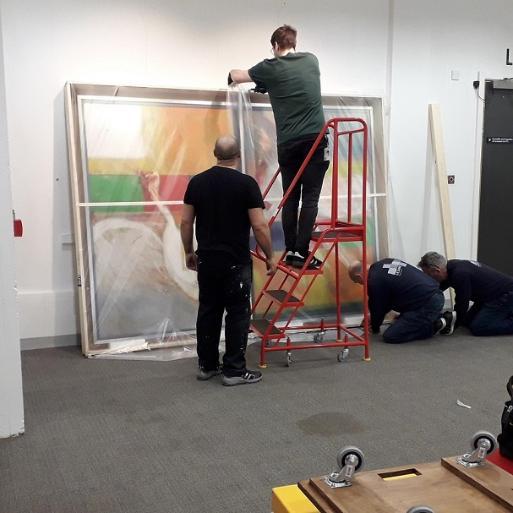
Big Bird is packed in a transit frame and carefully wrapped
In this case, Big Bird needed to be taken down from where it was displayed at the University. We had been told the date and time that the specialist art courier would be arriving to collect it, so we arranged to have it unfastened and lowered beforehand. It took three experienced art handlers plus a lifting table to do this. The couriers brought a transit frame for the painting to protect it on its journey; the photo above shows it being fitted into this and securely wrapped. My role was ‘supervisory’ i.e. taking photos and getting the brews in.
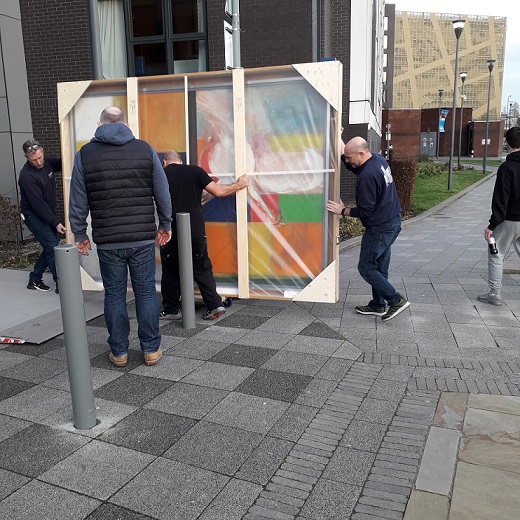
Big Bird is wheeled across to the van
There was drama when moving the painting towards the couriers’ van as it needed to be tilted to a somewhat precarious angle to get through the double doors of the building. It was then wheeled across a plaza towards the van; security bollards prevented parking the van any closer (see above). Once safely tethered onboard, Big Bird, along with a few paintings collected en route from other institutions, went off to London.

Big Bird just fits in the van
At the Barbican
The Barbican exhibition, Postwar Modern, was a survey of Modernist art in Britain in the period 1945 - 65 and featured about 200 artworks by 48 of the most important and influential artists of the era. It was brilliantly curated in a space that has its challenges when planning a thematic exhibition. Big Bird was hung on the first floor and absolutely glowed in the gallery. As you can see from the photo below, the exhibition was busy and Big Bird was getting lots of attention.
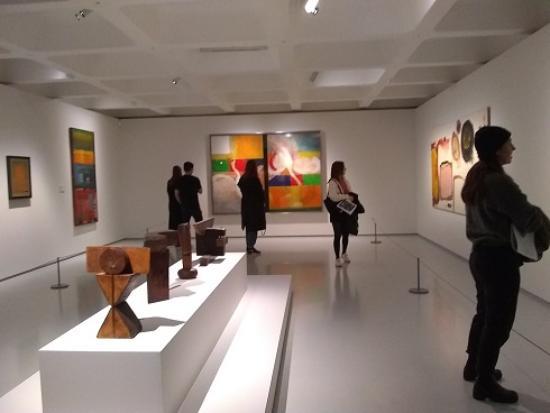
Big Bird on display in the Barbican, 2022 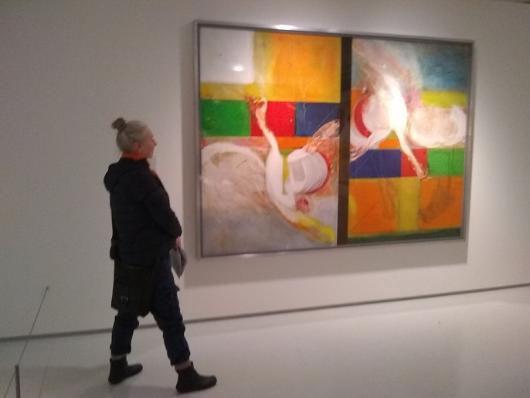
VG&M’s proud curator looking slightly out of focus in front of Big Bird at the Barbican
Big Bird back home
Big Bird was returned to us when the Barbican exhibition ended and was put back on its wall in the Central Teaching Hub building until the next time it is asked to fly away. You are welcome to come and see it for yourself.
References:
About Frank Bowling:
https://frankbowling.com/index.html
Mel Gooding: Frank Bowling (London, Royal Academy of Arts, 2021)
Elena Crippa (Ed.): Frank Bowling exhibition catalogue (London, Tate Publishing, 2019)
About the Frank Bowling exhibition at Tate Britain:
https://www.youtube.com/watch?v=BHIEj4Ca1hc Hoxton Radio interview with exhibition curator Elena Crippa (with Big Bird in background)
https://www.tate.org.uk/whats-on/tate-britain/frank-bowling
About Postwar Modern at the Barbican, 2022
https://www.barbican.org.uk/whats-on/2022/event/postwar-modern-new-art-in-britain-1945-1965
Keywords: Frank Bowling, Big Bird, Tate Britain, Barbican.